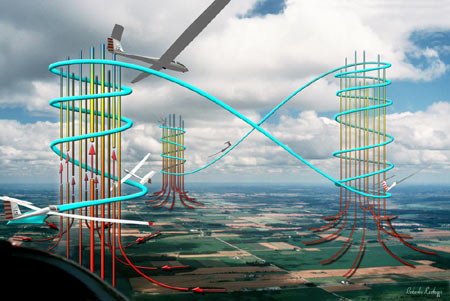How gliders fly
About Gliders: Gliders typically descend vertically between 100-200 feet per minute while traveling forward at 50-60 miles per hour in a normal descent. Gliders are in a constant state of descent always. Glider pilots are trained to understand the air currents. When a rising air current, or “thermal” is found it can keep the glider aloft only if the rate the thermal is rising is faster than the rate the glider is descending. When the sunlight reaches the surface of the earth, various terrain is heated at a different degree. For example, a black asphalt parking lot gets warmer than a nearby lake. The air above the parking lot rises up producing a thermal updraft. Other surfaces such as dark plowed fields, buildings, warehouses, etc are excellent producers of rising air currents.
In Florida, typical updraft strengths are around 500 feet per minute on a good soaring day. With a typical glider descending at 200 feet per minute through rising air of 500 feet per minute, the achieved climb rate is 300 feet per minute. In other words, when a glider finds an average thermal, it can climb about 1,000 feet in just three minutes.
“What if the wind quits!?” Gliders descend at such a slow rate, it’s almost like a leaf floating to the ground. The “wind” can power a glider to stay up for hours, and if it quits or isn’t there to begin with, you’ll at least be able to float around for in a slow descent for 20-45 minutes.
“Do you ever not land back at airport!?” Extremely rare! Guest rides are piloted within only a few miles of the airport, so the likeliness of this is virtually impossible. The Grob Twin in the picture below has a glide ratio of 38:1 meaning, if you’re 1 mile high, it can glide for 38 miles, truly an engineering marvel.

Would you like to fly at our Glideport?
Schedule a flight